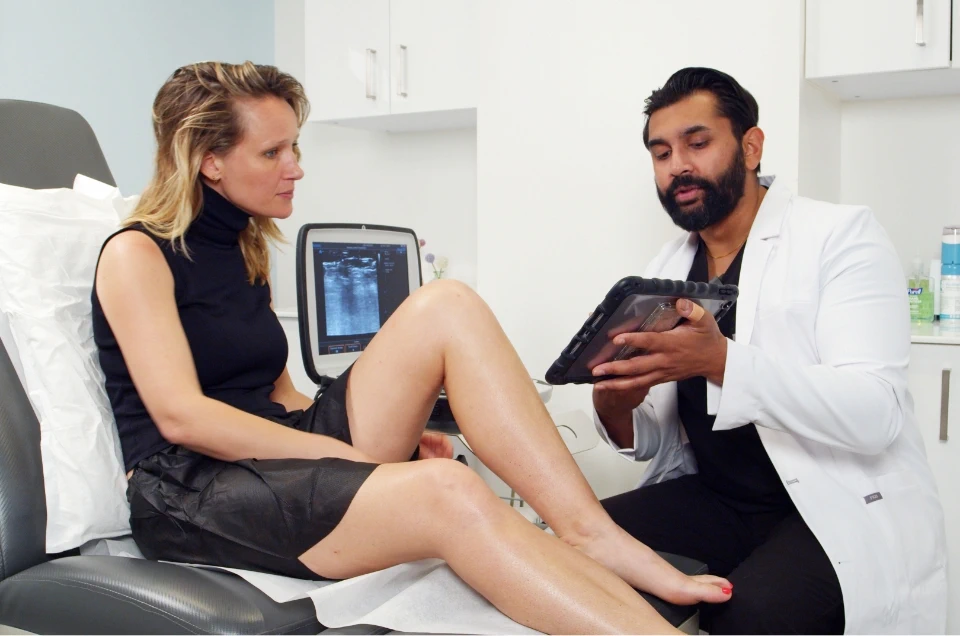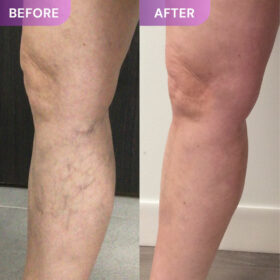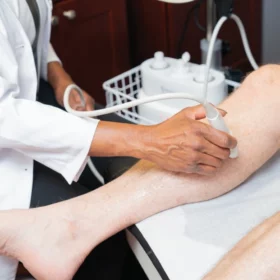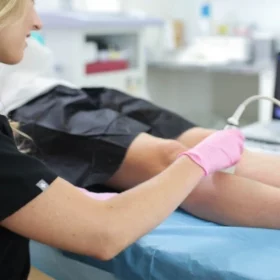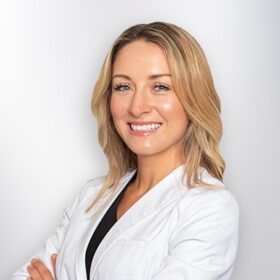At Vein Treatment Clinic, we understand the importance of comprehensive care when it comes to vein health. While minimally invasive vein treatments, such as sclerotherapy and endovenous laser treatment (EVLT), address the root cause of varicose veins and treat existing vein problems, incorporating complementary therapies into your routine can enhance your vein health and reduce the risk of future vein problems. In this article, we explore the best complementary therapies to improve overall vein health.
1. Compression Stockings
By wearing compression stockings, you can improve blood flow in your legs, reduce swelling, and alleviate discomfort associated with venous insufficiency. These garments apply gentle pressure to your legs, helping to support vein function and prevent blood from pooling.
When choosing compression stockings, it’s essential to select the right level of compression based on your individual needs and the recommendations of your vein specialist. Graduated compression stockings, which are tighter at the ankle and gradually loosen as they move up the leg, are particularly effective for promoting circulation and preventing varicose veins.
Tips for Wearing Compression Stockings to Improve Vein Health:
- Get professionally measured to ensure a proper fit.
- Select the appropriate compression level based on your vein health needs.
- Put on your compression stockings first thing in the morning before swelling occurs.
- Wear them throughout the day, especially during periods of prolonged sitting or standing.
- Wash your compression stockings regularly according to the instructions.
- Avoid using fabric softeners or harsh detergents that can degrade the elasticity of the material.
- Roll or fold the stocking down to the heel before putting it on.
- Use a donning aid or rubber gloves to help slide the stocking up smoothly.
- Monitor your compression stockings and replace them as soon as signs of wear appear.
- Consider purchasing multiple pairs to rotate between to prolong their lifespan.
- Engage in gentle exercises such as walking or flexing your ankles to promote blood flow.
- Avoid crossing your legs or sitting with your legs crossed, as this can restrict blood flow.
2. Exercise and Physical Activity
Regular exercise is vital for maintaining optimal vein health. Engaging in activities that promote muscle movement, such as walking, swimming, or cycling, helps to stimulate blood circulation and prevent blood from pooling in the legs. Strength training exercises that target the muscles in the lower body can also improve vein function by enhancing venous return.
In addition to structured exercise routines, incorporating more movement into your daily life can make a significant difference in your vein health. Simple activities such as taking the stairs instead of the elevator, stretching regularly throughout the day, and avoiding long periods of sitting or standing can help keep your veins healthy and functioning efficiently.
Tips for Exercise and Physical Activity to Improve Vein Health:
- Incorporate at least 30 minutes of moderate-intensity exercise into your daily routine.
- Include aerobic activities, such as walking or cycling, and strength training exercises.
- Include exercises that target leg muscles, such as squats, lunges, and calf raises.
- Perform leg lifts and ankle circles to stimulate blood flow and reduce swelling in the legs.
- Choose activities that are gentle on the joints, such as swimming or water aerobics.
- Include activities that elevate the legs above the heart, such as yoga or Pilates.
- Drink plenty of water before, during, and after exercise to maintain adequate hydration.
- Avoid excessive consumption of caffeinated or alcoholic beverages.
- Pay attention to how your body responds to exercise and adjust your intensity accordingly.
- Take breaks as needed to rest and elevate your legs, especially if you experience discomfort.
- Choose shoes with good arch support and cushioning to reduce strain on the feet.
- Avoid wearing high heels or shoes with narrow toe boxes, as they can restrict blood flow.
- Start with low-impact exercises and gradually progress to more challenging activities.
- Incorporate interval training or high-intensity workouts to enhance blood circulation.
3. Dietary Changes
A balanced diet plays a crucial role in supporting vein health and overall cardiovascular function. Consuming a variety of nutrient-rich foods such as fruits, vegetables, whole grains, and lean proteins provides essential vitamins and minerals that promote healthy blood circulation.
Foods rich in flavonoids, such as citrus fruits, berries, and dark leafy greens, have been shown to strengthen blood vessels and reduce inflammation, potentially lowering the risk of venous conditions. Omega-3 fatty acids found in fish, nuts, and seeds can also support cardiovascular health and improve blood flow. Reducing your intake of salt and processed foods can help prevent water retention and swelling, which are common symptoms of venous insufficiency.
Dietary Tips to Improve Vein Health:
- Incorporate citrus fruits, berries, dark leafy greens, and cocoa into your diet.
- Consume flavonoid-rich foods regularly to promote optimal blood circulation.
- Include fatty fish such as salmon, mackerel, and trout in your meals.
- Reduce your consumption of processed and salty foods, which can exacerbate swelling.
- Opt for fresh, whole foods and season dishes with herbs and spices instead of salt.
- Drink plenty of water throughout the day to support healthy blood circulation.
- Avoid excessive consumption of sugary beverages and caffeinated drinks.
- Include protein-rich foods in each meal to support overall cardiovascular health.
- Limit your intake of alcoholic beverages to reduce inflammation.
- Include fiber-rich foods to promote regular bowel movements, prevent constipation, and reduce pressure on the veins in the lower body.
4. Massage Therapy
Massage therapy can provide relief from symptoms associated with venous conditions while promoting relaxation and stress reduction. By applying gentle pressure and kneading techniques to the legs, a skilled massage therapist can help improve circulation, reduce swelling, and alleviate discomfort caused by varicose veins and spider veins.
Certain massage techniques, such as lymphatic drainage massage, focus on stimulating the lymphatic system to remove excess fluid and toxins from the body, which can benefit individuals with venous insufficiency. Additionally, self-massage techniques that you can perform at home, such as ankle pumps, can help improve blood flow in between professional sessions.
Minimally Invasive Treatments for Vein Health
Endovenous Laser Ablation (EVLA)
Endovenous laser ablation, also known as endovenous laser therapy (EVLT), is a minimally invasive procedure used to treat varicose veins and chronic venous insufficiency. During EVLA, a thin fiber-optic catheter is inserted into the affected vein under ultrasound guidance. Once positioned correctly, laser energy is delivered through the catheter, heating the vein walls and causing them to collapse and seal shut. Over time, the body absorbs the treated vein, redirecting blood flow to healthier veins nearby.
Radiofrequency Ablation (RFA)
Radiofrequency ablation is another minimally invasive technique used to treat venous reflux and varicose veins. Similar to EVLA, RFA involves the insertion of a catheter into the diseased vein under ultrasound guidance. Instead of laser energy, radiofrequency energy is used to generate heat, which heats and contracts the vein walls, leading to closure. Like EVLA, the body eventually absorbs the treated vein, rerouting blood flow to healthier veins. RFA is particularly suitable for larger veins and has a high success rate in reducing symptoms.
VenaSeal
VenaSeal is a relatively new, minimally invasive procedure that uses a medical adhesive to seal off diseased veins. During the procedure, a tiny catheter is inserted into the vein, and a specially formulated adhesive is injected directly into the vein. The adhesive rapidly polymerizes upon contact with blood, sealing the vein shut. Unlike thermal ablation techniques such as EVLA and RFA, VenaSeal does not require the application of heat. The sealed vein eventually gets absorbed by the body, and blood is rerouted through healthier veins.
ClariVein
ClariVein is a minimally invasive procedure that combines mechanical and chemical mechanisms to treat varicose veins. During the procedure, a rotating wire is inserted into the diseased vein, creating mechanical agitation to disrupt the vein wall. Simultaneously, a sclerosing agent is infused through the catheter, causing the vein to collapse and seal shut. ClariVein offers the advantage of combining mechanical disruption with sclerotherapy, resulting in effective closure of the treated vein and improved cosmetic outcomes.
Ambulatory Phlebectomy
Ambulatory phlebectomy is a minimally invasive surgical technique used to remove bulging varicose veins near the surface of the skin. During the procedure, small incisions are made along the course of the affected vein, and the vein is gently extracted using a specialized hook or forceps. Ambulatory phlebectomy is typically performed under local anesthesia on an outpatient basis, allowing patients to return home the same day. This procedure is particularly effective for removing visible varicose veins and improving the appearance of the legs.
Sclerotherapy
Sclerotherapy is a minimally invasive treatment for spider veins and small varicose veins. During the procedure, a sclerosing agent is injected directly into the affected vein, causing irritation and inflammation of the vein wall. This leads to the collapse of the vein and its eventual absorption by the body. Sclerotherapy is highly effective for treating superficial veins and can significantly improve the cosmetic appearance of the legs. Multiple sessions may be required to achieve optimal results, depending on the extent of the vein issue.
Contact VTC to Improve Vascular Health
Integrating the complementary therapies mentioned in this article into your vein health regimen can provide additional support and enhance the effectiveness of minimally invasive vein treatments like EVLT and RFA. Remember to consult with a vein specialist to develop a personalized treatment plan that addresses your specific needs and goals. At Vein Treatment Clinic, we’re here to help you achieve healthier veins and lead a more active life.


